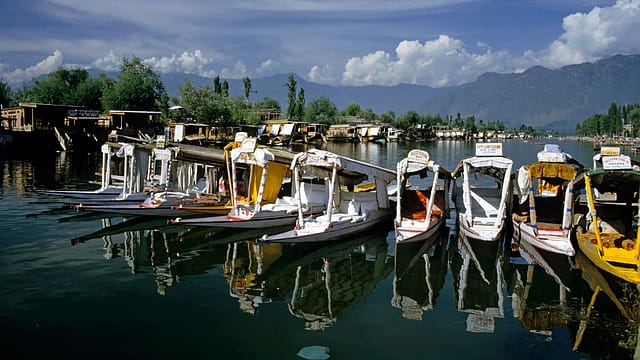Tourism takes a hit: Besides J&K, Ladakh, Himachal Pradesh, and Punjab bear the brunt of tensions
ADVERTISEMENT

Walking through the quiet, misty lanes of Dharamshala, Siddhartha, a young professional in his late twenties, soaked in the tranquillity he had long craved for. A trip to Himachal Pradesh had been on his mind for months, but it finally materialised under unusual circumstances. Amid simmering tensions between India and Pakistan, only one friend agreed to join him. Just a day after Pakistan’s military retaliation on Thursday, the duo arrived in the hill state, only to find an eerie calm blanketing the region.
While India and Pakistan agreed to a ceasefire on Saturday, the peak season of tourism has been hit. As Siddhartha found in Himachal Pradesh. At their Zostel stay, barely four or five other guests lingered—an unusual sight for what is typically peak tourist season. Roads were nearly deserted, cafés were quiet, and the buzz of summer tourism had faded into an unsettling stillness. What should have been a vibrant, crowded escape into the mountains now whispered of unease and uncertainty.
“Tourism across India has been impacted, we have cancellations even for cities such as Ayodhya and Shillong, let alone Himachal Pradesh, Ladakh, and Punjab,” says Varnika Chawla, founder, Trail the Himalayas, an experiential tours and travels company.
December 2025
The annual Fortune 500 India list, the definitive compendium of corporate performance, is out. This year, the cumulative revenue of the Fortune 500 India companies has breached $2 trillion for the first time. Plus, find out which are the Best B-schools in India.
In 2023, India’s western and northern regions—including Himachal Pradesh, Punjab, Jammu & Kashmir, Rajasthan, Ladakh, Gujarat, and Union Territories like Chandigarh and the Delhi NCR—collectively accounted for 18.87% of the country’s total tourist footfall, both domestic and foreign, according to the tourism ministry’s Annual Report for 2023–24.
That year, domestic tourism saw a significant surge, with 2,509.6 million (250.96 crore) visits recorded a 44.98% jump from 1,731 million (173.10 crore) in 2022. Foreign tourist arrivals also rebounded sharply, rising by 124.11% to 19.3 million (1.93 crore), up from 8.6 million (86 lakh) the previous year, signalling a strong post-pandemic recovery in travel demand.
It is this momentum that was hit because of geopolitical tensions at the beginning of the peak tourist season. This also led to frequent flight disruptions, with as many as 32 airports across India being shut.
But which state bore the brunt of the slump in tourism due to geopolitical tensions? These were the states and Union Territories that rely heavily on tourism, particularly summer tourism. This includes Jammu & Kashmir, Ladakh, and Himachal Pradesh, where the months between March and June account for the bulk of tourist footfall.
In Jammu & Kashmir, tourism is a critical economic driver. Of the ₹1.45 lakh crore real Gross State Domestic Product (GSDP) projected for 2024–25, tourism contributes around 7%, translating to an estimated ₹18,550 crore, as per the Budget speech delivered by J&K Chief Minister Omar Abdullah for 2025–26. The region, known for its scenic beauty and cultural richness, has witnessed sharp cancellations and deserted hospitality hubs.
Himachal Pradesh, another summer hotspot, saw 181.24 lakh tourists visit till December 2024, of which 180.41 lakh were domestic visitors. More than 40% of these visits occur during the March–June peak season. Tourism supports 7.78% of Himachal’s GSDP, fuelling local economies through hospitality, transportation, handicrafts, and other allied sectors. The state is home to 4,905 registered homestays. This year, however, a significant part of that inflow was under threat.
Ladakh, which had recently emerged as a trendy offbeat destination, perhaps faced the most acute blow. The Union Territory has around 1,220 homestays and 687 guest houses, according to official data. “Almost all have cancelled at least for the Ladakh trip. People are cancelling just a day before their travel,” says Chawla of Trail The Himalayas.
Even in Rajasthan, typically resilient due to its diversified tourism base, travel operators in Jodhpur and Jaisalmer reported being asked by local authorities to suspend engagements.
The hardest hit has been the local operators—the backbone of the travel economy. From homestay owners and tour guides to transport providers and small business vendors, it is those on the ground who bear the brunt. Many had taken loans to expand their services, betting on a strong summer season and the steady growth of India’s tourism sector. With cancellations mounting and footfall collapsing, their repayments, livelihoods, and financial stability were at serious risk. “A loss of even one month of the four peak months of summer means a significant loss of business,” Chawla explains.
For Chawla herself, despite being in the industry for many years, an estimated 50–60% of her business is expected to be affected. “For us, the impact began when the Pahalgam attack happened. Kashmir is an important region for us, [and] contributes roughly about 3-4% of our total business, and that primarily we saw coming to [a complete] stand still over the last couple of weeks,” Amit Damani, founder, StayVista Hotels, tells Fortune India
Prior to Operation Sindoor, Damani says other regions remained largely unaffected in terms of travel and tourism. However, over the past few days, the escalating tensions disrupted flight routes, triggering a noticeable impact. Himachal Pradesh has emerged as one of the regions facing significant travel disruptions, followed closely by Punjab. Alongside Jammu & Kashmir, these two states are currently experiencing the most visible fallout on tourism activity.
For StayVista, the regions account for roughly 7% of their total business that has been impacted. Damani anticipates a similar drop will come from all its properties across bordering states.
There, however, is a silver lining. “The best part is that travellers have short-term memory; once things get back to normal, most will come back,” says Chawla.
